Abstract
A mutant of Escherichia coli lacking hydroxyethylthiazole kinase (EC 2.7.1.50) was produced by a further mutation of a temperature-sensitive, auxotrophic mutant for hydroxyethylthiazole. The parent cells possessed two distinct enzymes capable of phosphorylating hydroxyethylthiazole: one was hydroxyethylthiazole kinase, and the other was a phosphotransferase species that required p-nitrophenylphosphate as a phosphoryl donor. Osmotic shock fluid prepared from the mutant cells phosphorylated hydroxyethylthiazole to an extent comparable to that observed with shock fluid from the parent cells, whereas extracts from shocked cells were unable to catalyze the kinase reaction. Shock fluid from a mutant of the other type obtained as a reduced phosphatase activity against p-nitrophenylphosphate did not show any appreciable activity for the phosphotransferase reaction, while extracts from shocked cells showed full kinase activity. The former mutant had lost its ability to grow on hydroxyethylthiazole at high temperature, but the latter mutant still responded to it. It thus appears that the kinase is an enzyme which might play a role in the biosynthesis of thiamine PPi in situ. By conjugation and P1 transduction, a gene governing hydroxyethylthiazole kinase activity, for which we propose the designation thiM, was mapped on the chromosome close to thiD, a gene specifying phosphomethylpyrimidine kinase activity.
Full text
PDF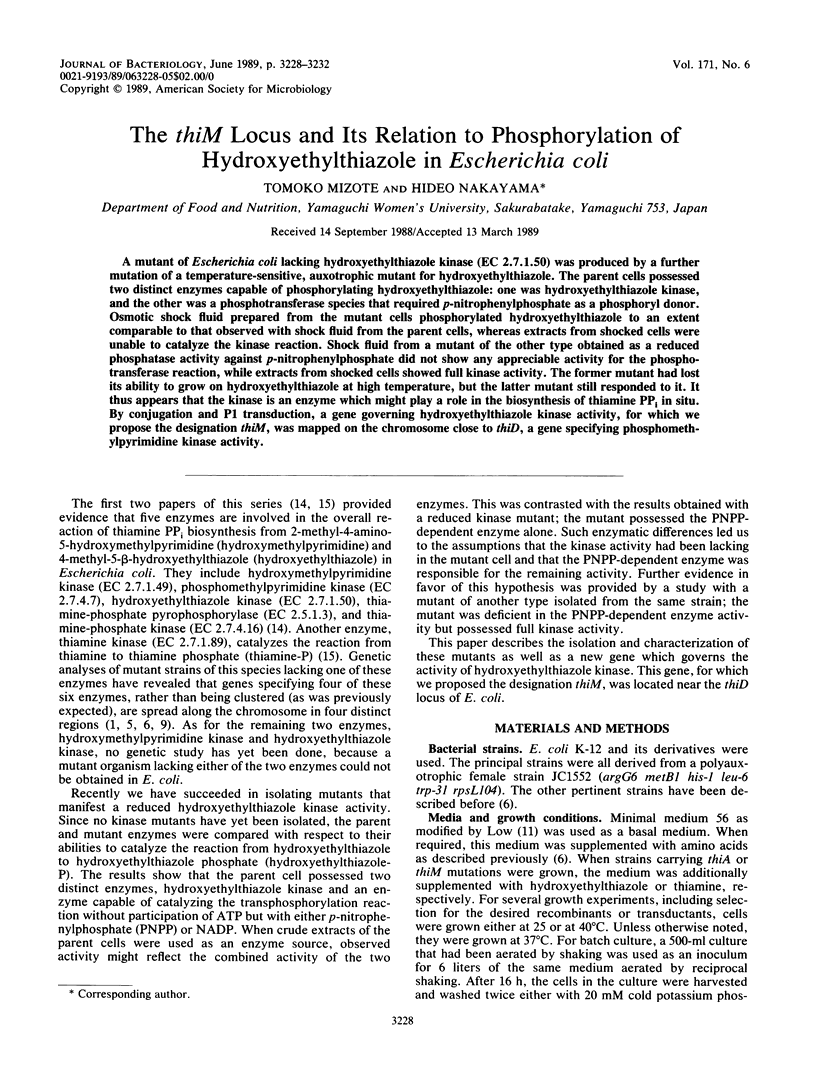
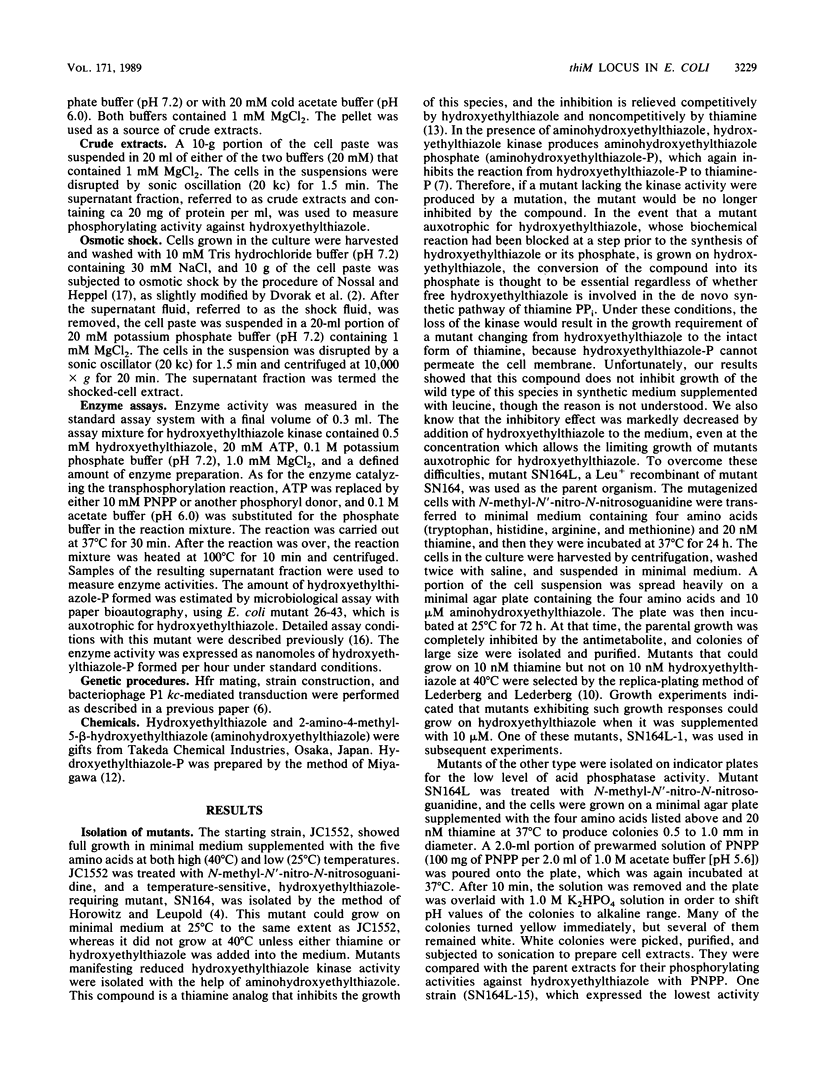
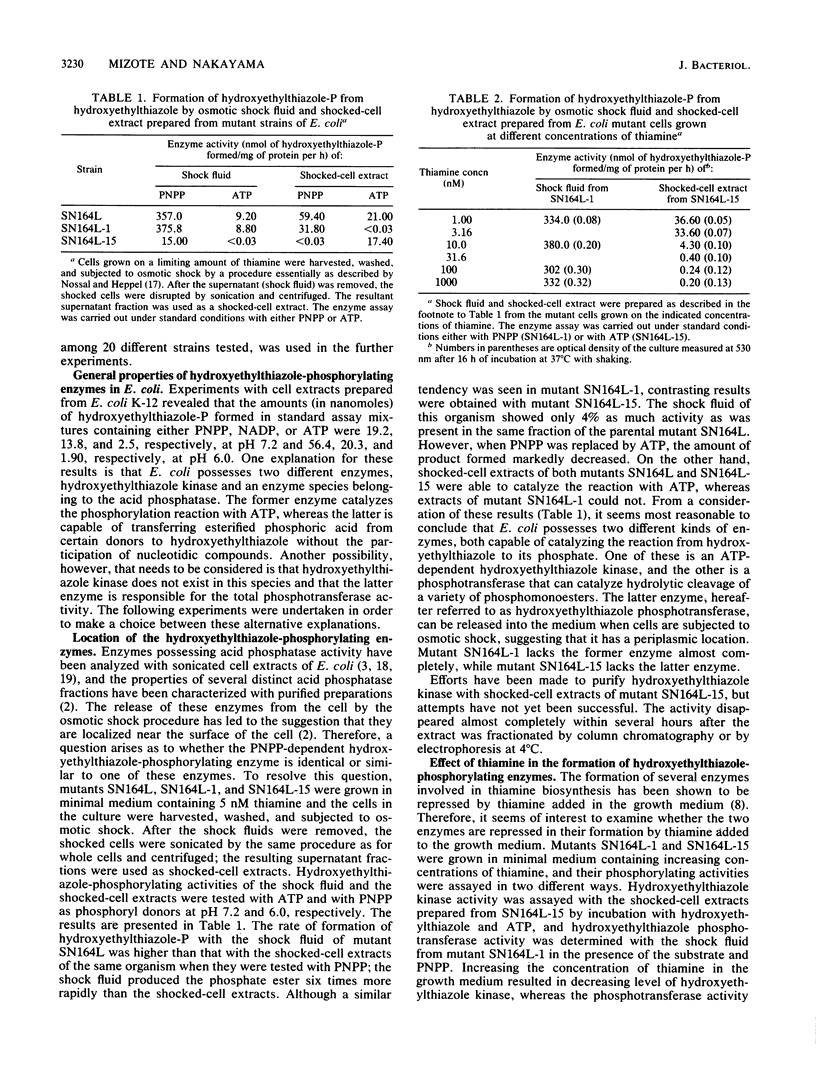
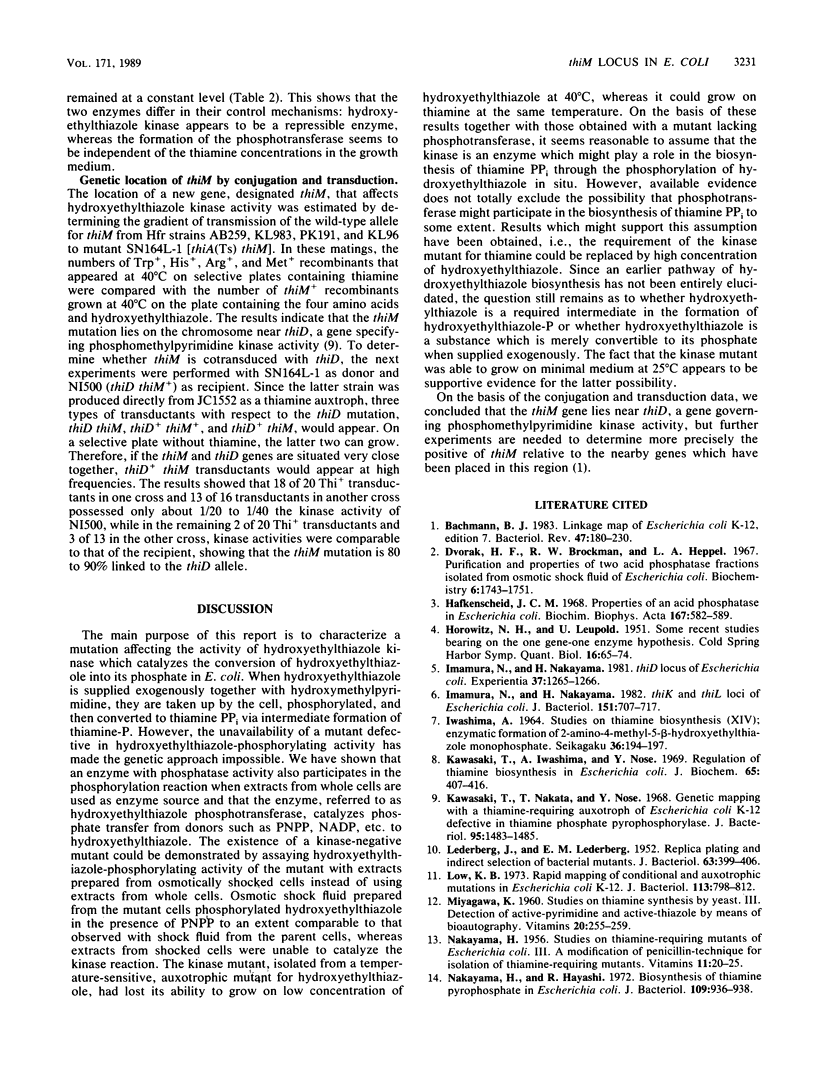
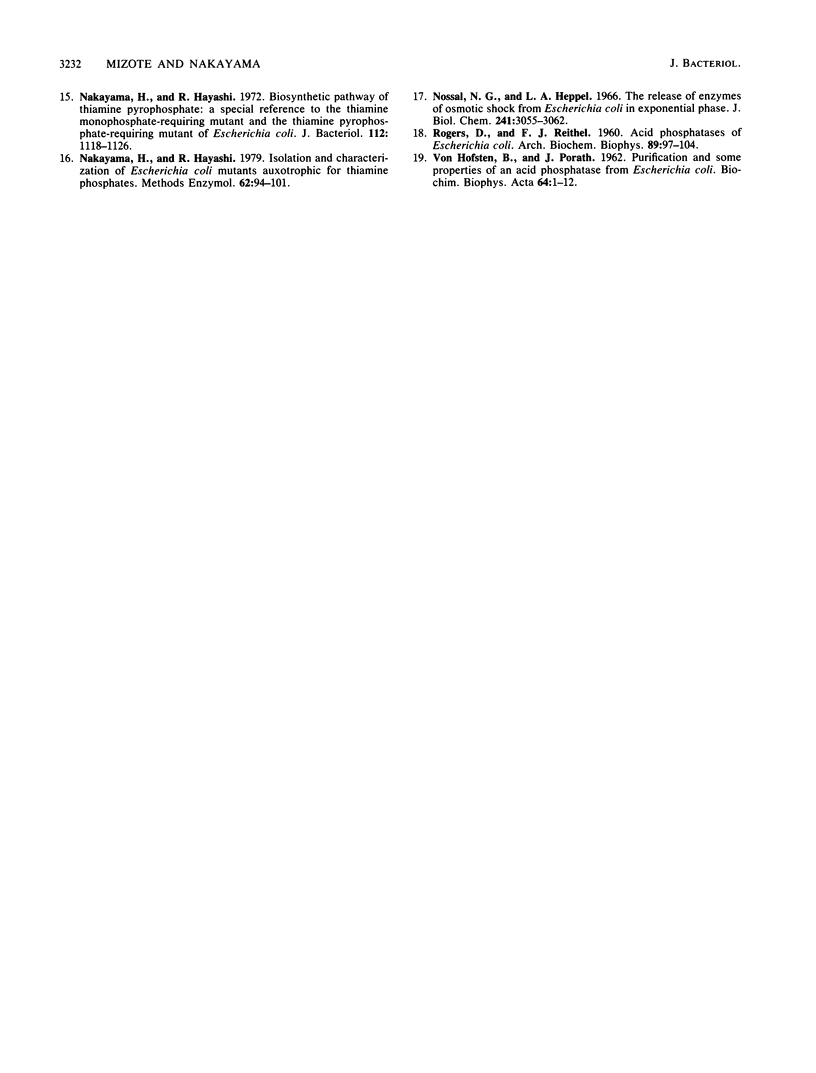
Selected References
These references are in PubMed. This may not be the complete list of references from this article.
- Bachmann B. J. Linkage map of Escherichia coli K-12, edition 7. Microbiol Rev. 1983 Jun;47(2):180–230. doi: 10.1128/mr.47.2.180-230.1983. [DOI] [PMC free article] [PubMed] [Google Scholar]
- Dvorak H. F., Brockman R. W., Heppel L. A. Purification and properties of two acid phosphatase fractions isolated from osmotic shock fluid of Escherichia coli. Biochemistry. 1967 Jun;6(6):1743–1751. doi: 10.1021/bi00858a024. [DOI] [PubMed] [Google Scholar]
- HOROWITZ N. H., LEUPOLD U. Some recent studies bearing on the one geneone enzyme hypothesis. Cold Spring Harb Symp Quant Biol. 1951;16:65–74. doi: 10.1101/sqb.1951.016.01.006. [DOI] [PubMed] [Google Scholar]
- Hafkenscheid J. C. Properties of an acid phosphatase in Escherichia coli. Biochim Biophys Acta. 1968 Nov 19;167(3):582–589. doi: 10.1016/0005-2744(68)90048-x. [DOI] [PubMed] [Google Scholar]
- Imamura N., Nakayama H. thiD locus of Escherichia coli. Experientia. 1981 Dec 15;37(12):1265–1266. doi: 10.1007/BF01948350. [DOI] [PubMed] [Google Scholar]
- Imamura N., Nakayama H. thiK and thiL loci of Escherichia coli. J Bacteriol. 1982 Aug;151(2):708–717. doi: 10.1128/jb.151.2.708-717.1982. [DOI] [PMC free article] [PubMed] [Google Scholar]
- Kawasaki T., Nakata T., Nose Y. Genetic mapping with a thiamine-requiring auxotroph of Escherichia coli K-12 defective in thiamine phosphate pyrophosphorylase. J Bacteriol. 1968 Apr;95(4):1483–1485. doi: 10.1128/jb.95.4.1483-1485.1968. [DOI] [PMC free article] [PubMed] [Google Scholar]
- Kawasi T., Iwashima A., Nose Y. Regulation of thiamine biosynthesis in Escherichia coli. J Biochem. 1969 Mar;65(3):407–416. doi: 10.1093/oxfordjournals.jbchem.a129028. [DOI] [PubMed] [Google Scholar]
- LEDERBERG J., LEDERBERG E. M. Replica plating and indirect selection of bacterial mutants. J Bacteriol. 1952 Mar;63(3):399–406. doi: 10.1128/jb.63.3.399-406.1952. [DOI] [PMC free article] [PubMed] [Google Scholar]
- Low B. Rapid mapping of conditional and auxotrophic mutations in Escherichia coli K-12. J Bacteriol. 1973 Feb;113(2):798–812. doi: 10.1128/jb.113.2.798-812.1973. [DOI] [PMC free article] [PubMed] [Google Scholar]
- Nakayama H., Hayashi R. Biosynthesis of thiamine pyrophosphate in Escherichia coli. J Bacteriol. 1972 Feb;109(2):936–938. doi: 10.1128/jb.109.2.936-938.1972. [DOI] [PMC free article] [PubMed] [Google Scholar]
- Nakayama H., Hayashi R. Biosynthetic pathway of thiamine pyrophosphate: a special reference to the thiamine monophosphate-requiring mutant and the thiamine pyrophosphate-requiring mutant of Escherichia coli. J Bacteriol. 1972 Dec;112(3):1118–1126. doi: 10.1128/jb.112.3.1118-1126.1972. [DOI] [PMC free article] [PubMed] [Google Scholar]
- Nakayama H., Hayashi R. Isolation and characterization of Escherichia coli mutants auxotrophic for thiamine phosphates. Methods Enzymol. 1979;62:94–101. doi: 10.1016/0076-6879(79)62198-5. [DOI] [PubMed] [Google Scholar]
- Nossal N. G., Heppel L. A. The release of enzymes by osmotic shock from Escherichia coli in exponential phase. J Biol Chem. 1966 Jul 10;241(13):3055–3062. [PubMed] [Google Scholar]
- ROGERS D., REITHEL F. J. Acid phosphatases of Escherichia coli. Arch Biochem Biophys. 1960 Jul;89:97–104. doi: 10.1016/0003-9861(60)90018-7. [DOI] [PubMed] [Google Scholar]
- von HOFSTEN, PORATH J. Purification and some properties of an acid phosphatase from Escherichia coli. Biochim Biophys Acta. 1962 Oct 8;64:1–12. doi: 10.1016/0006-3002(62)90754-0. [DOI] [PubMed] [Google Scholar]


